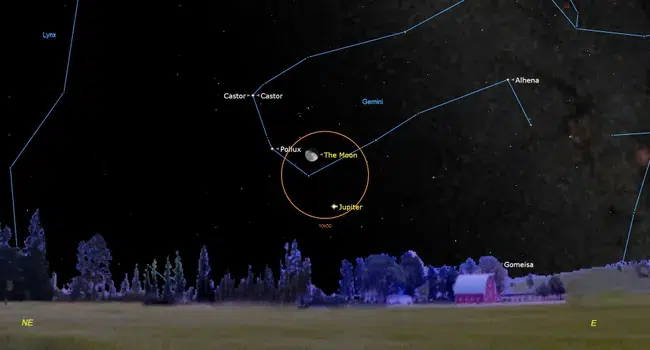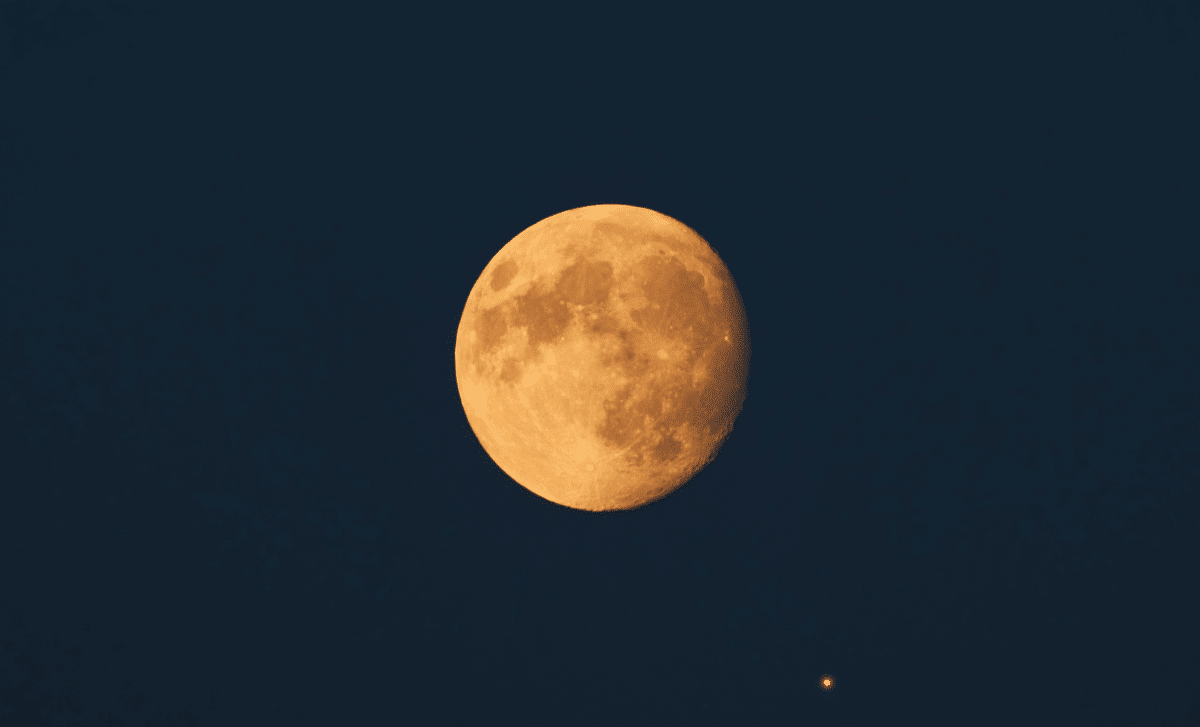Tonight, skywatchers are in for a rare and spectacular treat as the Moon and Jupiter align in the night sky. Whether you’re an amateur stargazer or a seasoned astronomer, this event offers a great chance to observe two of the most prominent celestial objects. The best part? You don’t need any special equipment to catch a glimpse of this alignment — just look to the east-northeast after sunset for a breathtaking view of the waning gibbous Moon and the brilliant planet Jupiter.
Jupiter and the Moon: A Celestial Pairing You Won’t Want to Miss
On Sunday night, the Moon will be about 72% illuminated, casting a soft glow across the night sky. Just below it, Jupiter will appear as a bright, steady “star,” outshining most other objects in the sky. The alignment will occur around 10 p.m. local time, and while it won’t last for long, the celestial pairing will be visible to anyone who ventures outside. The two objects will be separated by only about 4.5 degrees, making it easy to spot them together, especially if you hold out your clenched fist at arm’s length — the distance between them will be about half that size. It’s a sight that promises to dazzle even casual stargazers.
This event isn’t just a treat for the eyes. Space.com points out that Jupiter is currently positioned against the stars of Gemini the Twins, which makes it visible for a longer stretch of time across the night sky, especially for observers in the Northern Hemisphere. This makes Sunday’s alignment an exciting opportunity for those who might not often get a chance to see Jupiter so high and bright.
How and When to See the Alignment: A Guide for Stargazers
Timing is key for this skywatching event, and depending on where you are in the United States, the exact moment of alignment will vary. For those in the Eastern Time Zone, expect the alignment to occur just after 1:45 a.m. on Monday morning. If you’re in the Pacific Time Zone, the alignment will happen earlier — around 10 p.m. local time, as the Moon rises low in the eastern sky. It’s important to be aware of the timing, as the position of the Moon relative to Jupiter will change throughout the night.
As the night wears on, the Moon will continue to shift eastward, gradually separating from Jupiter and Pollux, another bright star in the constellation Gemini. By the time dawn breaks, the Moon will have moved far away from Jupiter, marking the end of this celestial alignment. For those staying up late, it’s a perfect chance to witness how the position of these objects evolves over the course of the night.
The Science Behind the Show: Why Jupiter Is So Visible Right Now
For those wondering why Jupiter is so prominent in the night sky right now, it’s because the planet is currently situated along the ecliptic at a high declination of +23 degrees. This means that Jupiter is located further north in the sky, and the farther north a planet is, the longer it stays above the horizon and the higher it reaches in the sky. This positioning is a boon for skywatchers in the Northern Hemisphere, where the planet will shine brightly well into the evening hours.
Jupiter will be especially visible for those in the southern U.S., where the planet will be near its zenith, directly overhead, as it crosses the meridian during the early morning hours. This makes it an excellent time to observe the planet, especially if you’re using a telescope to catch details like its famous Galilean moons.
 Skywatchers keep your eyes peeled for the moon and Jupiter to get close to each other in the night sky. (Image credit: Chris Vaughan/Starry Night)
Skywatchers keep your eyes peeled for the moon and Jupiter to get close to each other in the night sky. (Image credit: Chris Vaughan/Starry Night)
A Telescopic Treat: What to Look for Beyond the Alignment
If you’re lucky enough to have access to a telescope, Sunday night’s skywatching event offers more than just a visual treat. Jupiter is currently one of the best planets to observe, and its Galilean moons — Io, Europa, Ganymede, and Callisto — are clearly visible through even small telescopes. As you track the moons across the sky, you’ll notice their ever-changing positions relative to one another. It’s a dynamic show, and for many stargazers, it’s one of the most fascinating aspects of observing Jupiter.
However, keep in mind that observing Jupiter in the most ideal conditions requires the planet to be at least 30 degrees above the horizon, which means you’ll have to wait until later in the evening, around midnight, for the best telescopic views. The further the planet rises, the clearer the image will be, as the turbulent atmosphere near the horizon often distorts the view.

